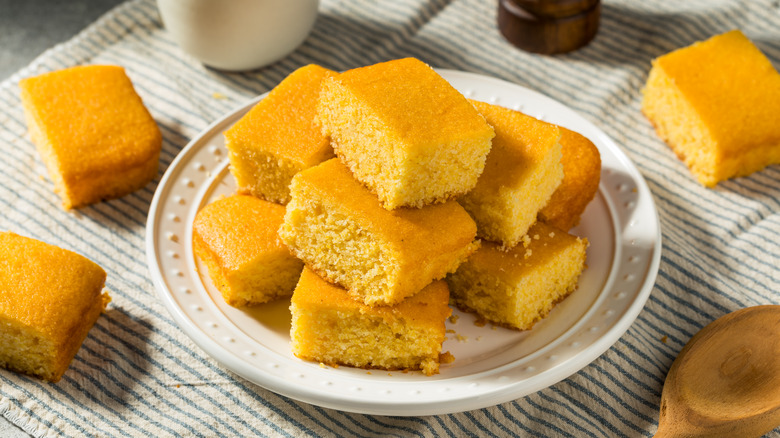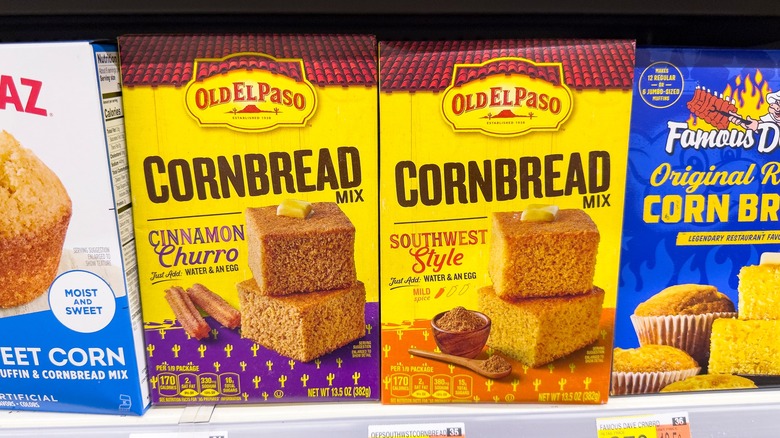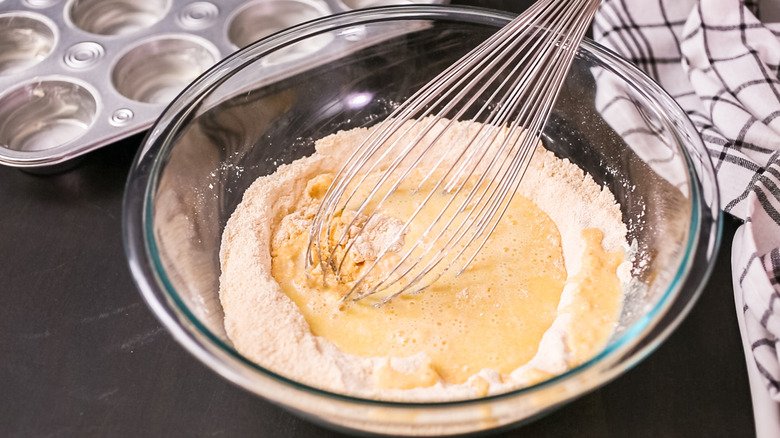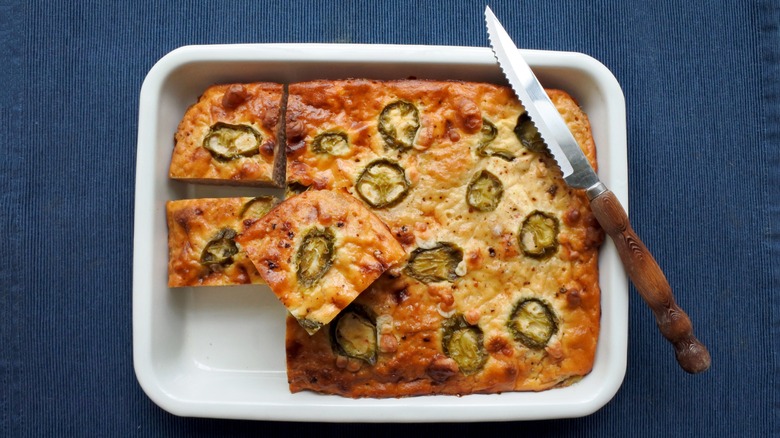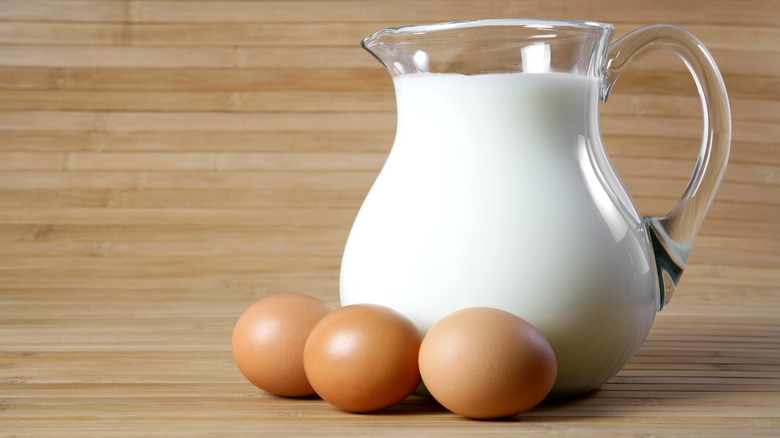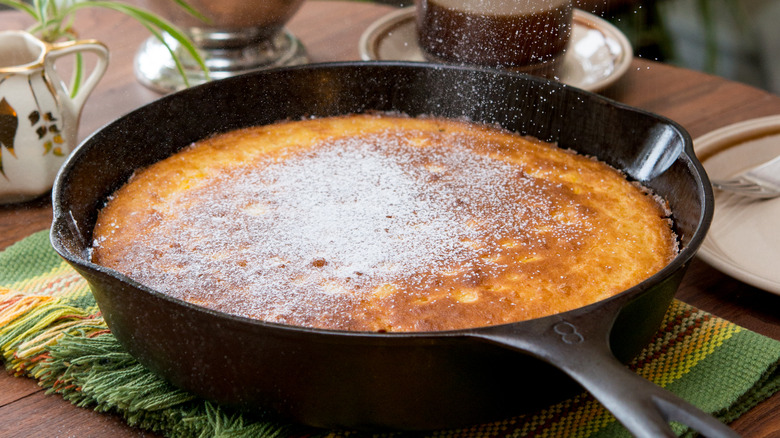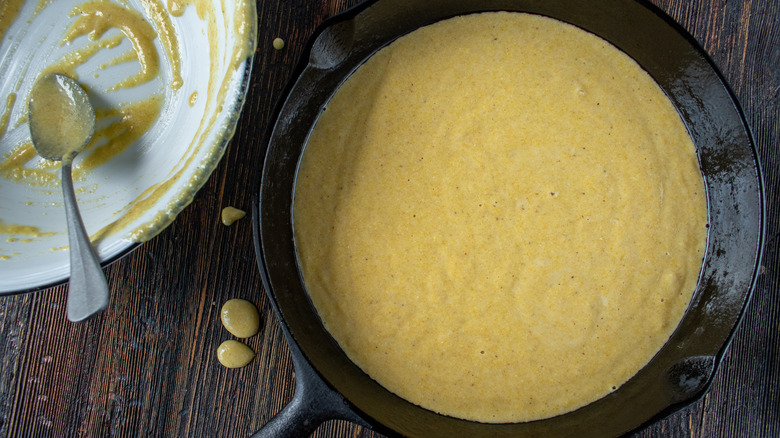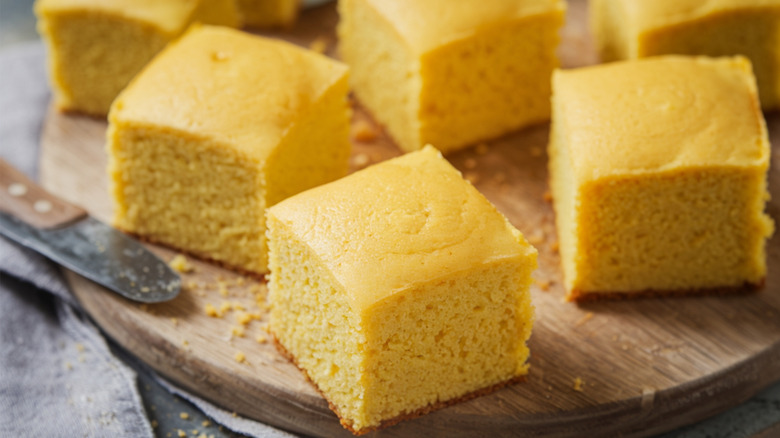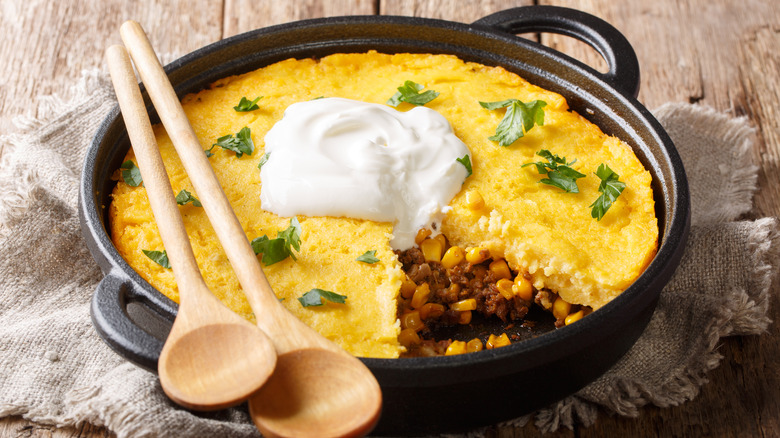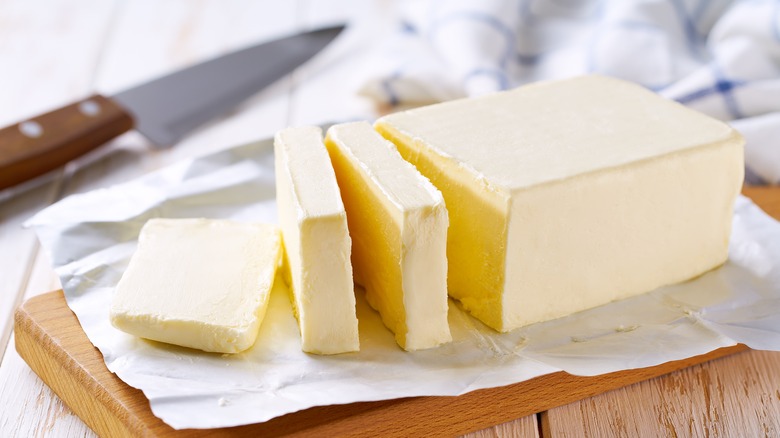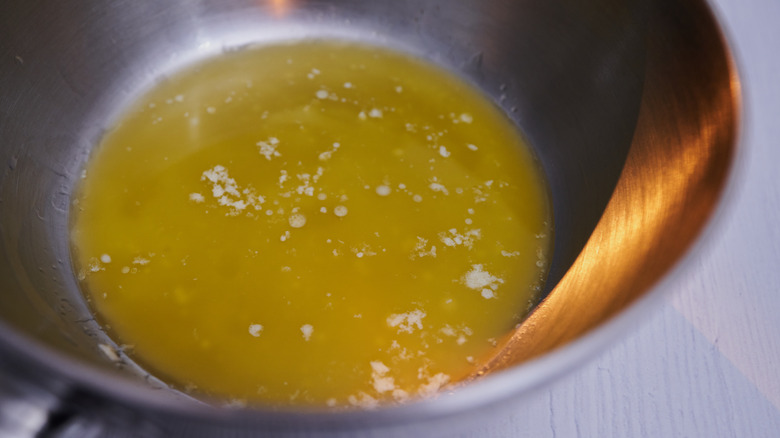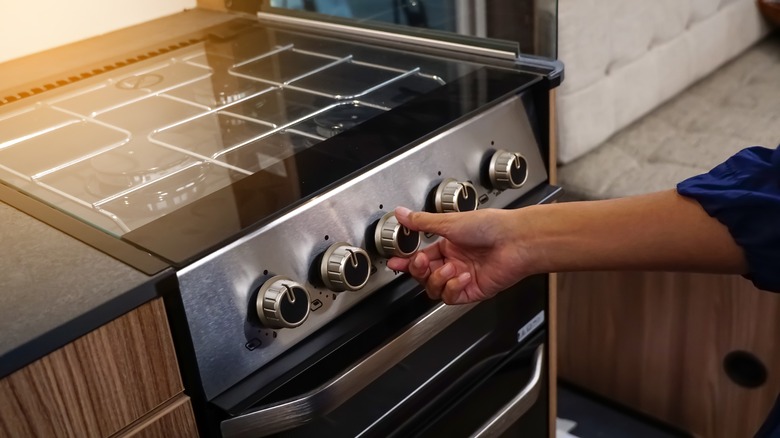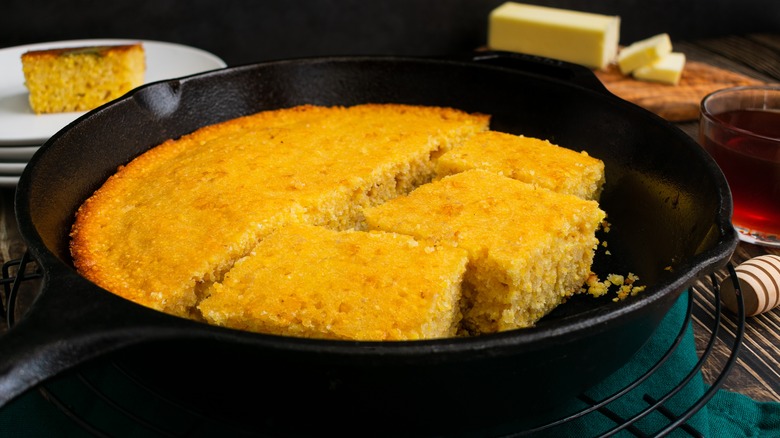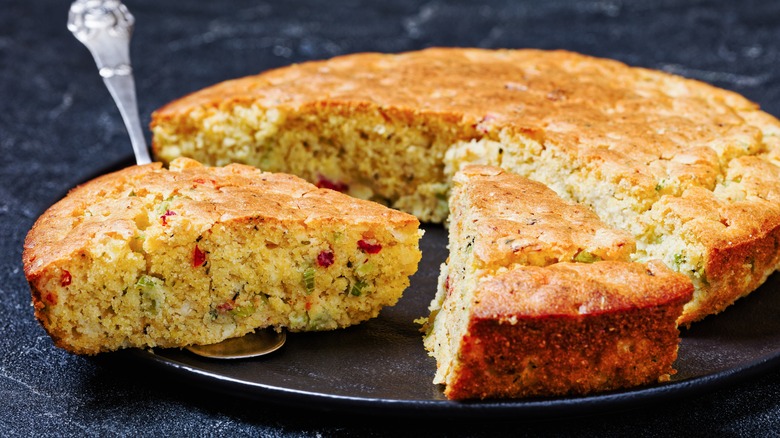Mistakes Everyone Makes With Boxed Cornbread Mix
Moist, a little crumbly, and slightly sweet with a distinctive corn flavor, cornbread is the perfect side for chili, soups, stews, and so much more. Better yet, it's easy to make from a box when you don't have the time or inclination to bake it from scratch. But the fact is, many people make mistakes with boxed cornbread mix, leaving it not as good as it should be.
A good boxed version is almost as delicious as a totally homemade one. But if yours often ends up overly crumbly, dry, flat, or lacking in flavor, you might be making one of many common errors. Luckily, once you know the potential pitfalls surrounding boxed cornbread, you'll be able to avoid them. Never again will you have to struggle through a batch that's not really worth eating.
We're going to go through the most prevalent errors that folks make with their boxed cornbread mixes, but we'll also talk about how to fix these issues or avoid them altogether. Next time you whip up a batch to go with an impromptu meal, nobody will believe it came from a packet.
Assuming all boxed cornbread is equally good
The first place that you can go wrong is with the mix itself. If you assume that all boxed cornbread is equally good, you're in for a rude awakening. Some versions end up virtually indistinguishable from something made from scratch, while others will make you wish you hadn't bothered.
But how do you know which to buy? We ranked boxed cornbread mix from worst to best, which might help you out. Right at the bottom of our list is the Martha White brand. It might have existed since 1899, but it's among our least favorite offerings with a lackluster flavor and a dry, overly crumbly texture.
Toward the other end of the spectrum, Zatarain's Honey Butter Cornbread Mix is our runner-up. It's one of the closest to homemade that you can make from a box, with a moist, cakey consistency and a good amount of sweetness. But it's that old classic, Jiffy Corn Muffin Mix that wins the top spot. It's popular for a reason and is even the cornbread mix that Sunny Anderson swears by – and that's a resounding seal of approval. What's more, it's easy to find, and available in most grocery stores.
Overmixing boxed cornbread batter
Cornbread isn't like other bread when it comes to mixing. Since you have to knead loaves made from wheat to get a good texture, many people assume that you should thoroughly mix cornbread, too. But this can lead to overmixing the batter, giving you poor results.
Mixing cornbread batter too thoroughly can lead to cornbread that's dense, tough, dry, crumbly — or a lovely mix of all those properties. This is especially true of versions that contain wheat alongside the cornmeal. When you overmix it, too much gluten develops, which gives you tough, dry results. In terms of mixing, you should think of cornbread more like a cake than a bread.
You only need to mix your cornbread until it comes together and there are no streaks of dry ingredients throughout the batter. It's fine if there are some small lumps. Beating the mixture until all the lumps are gone can lead to overmixing. Generally, you don't even need an electric beater — just a whisk or a wooden spoon will do the trick and make overmixing less likely.
Following the package directions exactly
Of course you want package directions on a box of cornbread to let you know how much liquid and other ingredients to add to make it come together. However, if you treat these packet directions like law rather than guidelines, you're missing out on making the finished bake even more delicious. You should be open to making tweaks to level up your cornbread.
For instance, if the packet calls for water, you'll always get more flavorful results by using milk instead. Or, if you avoid dairy, soy milk, oat milk, or any other non-dairy milk of choice will do the trick. Then, there's the one-ingredient upgrade your boxed cornbread needs: mayonnaise. Add around half a cup of mayo alongside the other ingredients called for and expect moister, richer results.
Plus, you'll find all kinds of hacks to make boxed cornbread mix taste homemade. Adding fresh corn kernels is an easy way to fool everybody into thinking you made it from scratch and only takes a few extra minutes — even less if you use frozen corn. Sour cream and buttermilk add a pleasant tang, plus they introduce more moisture, which is ideal if your cornbread often comes out dry or too crumbly. There's also the option to add jalapeños for a kick or cheese for a savory richness. Whatever you add or adjust, following the directions to the letter is not the one.
Using eggs and dairy straight from the fridge
Different cornbread mixes call for different ingredients, but milk, eggs, and butter are all common additions. Whichever combination your box calls for, you'd better not be getting these ingredients out of the fridge and putting them straight in the batter. We get that boxed mixes offer a shortcut, but you'll get better results if you give eggs and dairy the time to come to room temperature before using them.
The problem is that cold ingredients don't mix into a batter evenly. This can leave you with lumpy, curdled results. Baking relies on the ingredients in batters emulsifying — this means the fats and liquids mix together. When emulsified, cornbread mixture traps air more easily, so it turns out lighter and more moist. It's a big part of what gives you the perfect texture
So, if you use cold eggs and dairy in your batter, the resulting cornbread can be flat, dense, dry, or overly crumbly. The easy way to fix this is just to get the ingredients you want to add out of the fridge ahead of time. We know baking can be a spontaneous desire, though. In this case, you can get your eggs to room temperature more quickly in a large bowl of warm tap water. Butter and milk you can soften or take the chill off by briefly nuking them in the microwave. Start with bursts of 10 to 20 seconds.
Not considering adding sugar
The topic of adding sugar to cornbread is a divisive one. Some people prefer the drier, less sweet cornbread common in the southern states, while others prefer the sweeter, cakier cornbread that's more often found in the north. However, the divide doesn't seem to be solely geographical — sometimes folks from the south have grown up on sweet cornbread or those from the north on more savory offerings.
We know it isn't simple — but even so, it's a mistake not to at least consider adding extra sugar to your boxed cornbread mix. Most boxed versions are fairly conservative with their sugar content, since it's easy for people to add extra to taste but impossible to make a mix less sweet. However, it's a good idea to try a mix at least once without added sugar in case it's already fairly sweet.
Generally, just a couple of added tablespoons of sugar will do the trick. It helps give the cornbread a brown, caramelized top and a slightly crunchy underside. Honey, agave, and other alternative sweeteners are also an option if you prefer.
Baking the batter as soon as it's mixed
Mix up your batter, pour it into the pan, bake it — seems like a logical series of steps. But, in actual fact, it's a common error to bake the mixture as soon as you've whipped it up. For the best results, you should give it some resting time.
Ideally, you should rest the batter for at least three to four minutes. This is often specified on the package directions. However, you'll get even better results by extending the rest time to more like six to eight minutes. Resting gives the gluten in the batter time to relax and develop.
Your resulting cornbread should be well-risen with a nice dome to it. Without the resting time, it often ends up flat and dense. So, even if it pushes your dinner back by five minutes or so, it's worth taking that little bit of extra time to rest the batter.
Underbaking or overbaking boxed cornbread
Either underbaking or overbaking cornbread is extremely common. Neither option is a good one and leaves you with subpar results. So, it's important to get the bake just right and allow for any differences in oven temperature and performance.
Underbaked cornbread can be unpleasantly gummy in the center. When you take it out before it's done, it may also end up sinking after a few minutes — so what looked perfectly risen can turn dense and flat. Overbaked cornbread can burn. But even before you get to this stage, it will dry out and become annoyingly crumbly, rather than the slight crumbliness you expect.
In theory, baking cornbread for the correct time is easy. You just follow the directions on the packet and it should come out perfectly. But we all know the real world is messy and unpredictable. When it comes down to it, some ovens run hotter and circulate air more effectively than others. Then there are factors such as pan size and the temperature of the batter when it goes in the oven. So use the cooking time on the packet as a guide but also look for other clues. Perfectly done cornbread will be golden brown on top and a toothpick will come out clean when inserted into the center.
Only using the mix to make cornbread
You've got a box of cornbread mix — that means it's time to bake cornbread, right? Well, not necessarily. There are other delicious dishes you can make with a boxed mix, and if you aren't exploring them, you're missing out.
Cornbread mix should be part of your next brunch gathering. You can use it to make pancakes and waffles, with a sweetness and complexity you don't get from using wheat flour alone. You don't use it as directed on the package, though, so find yourself a solid recipe and go from there. You can serve these with other brunch favorites like fresh fruit, eggs, syrup, and more. Don't forget the coffee and juice.
Plus, there are countless other recipes you can make with a box of cornbread. Pot pie, cornbread pizza, savory muffins, corn dogs, casseroles, stuffing, apple crisp — the list goes on. We have an easy tamale pie recipe that involves a packet of cornbread mix. Ultimately, you can use it in so many ways that it would be a shame to only ever make straight-up cornbread.
Not greasing the pan sufficiently
You've made what looks like the perfect cornbread. It's golden on top, it looks amazing, and it's slightly springy when you press it — the dream. But, when you come to turn it out of the pan, no dice. It's stuck fast and you end up butchering it on the way out. The culprit is probably just that you didn't grease the pan enough.
The trouble with cornbread is that it's particularly good at sticking. So, even if you're using a nonstick pan or a well-seasoned cast iron skillet, you can't assume that it will slide right out when you're done. You should always liberally grease your pan with either butter or oil. Butter is the more flavorful option but feel free to use what you have on hand.
It's better to be generous with the greasing. It won't hurt to overdo it, but if you don't add enough oil or butter, you might find yourself in a sticky situation. Greasing can also help with getting a nicely crispy underside to your cornbread, which is an additional bonus.
Using oil instead of melted butter
Some cornbread mixes call for oil to be added along with milk and occasionally eggs. While it seems to make sense to follow the directions on the box, oil doesn't add much in the way of flavor. And those that do have a strong taste — such as extra virgin olive oil — have the wrong flavor profile for cornbread. The better option is to use melted butter in place of oil.
Butter has a richer flavor and adds more than just a moist texture to the finished product. Using butter makes boxed cornbread taste more like it was made from scratch. The thing to account for is the difference in fat content, though. Butter is around 80% fat while oil is 100% fat. This means you need to use more butter than oil to make up for it. A 3:4 ratio of oil to butter is ideal — that means you use four parts butter for every three parts oil. So, if a recipe called for three tablespoons of oil, you'd use four tablespoons of butter.
But why melted? There's nothing special about melted butter, it just mixes in with the dry ingredients more easily than solid butter. It doesn't take long to melt it in the microwave or a pan on the stovetop.
Cooking at a higher or lower oven temperature than directed
You might think that you can play it fast and loose with oven temperature. Perhaps you're in a hurry and you think that baking at a higher temperature will save you time. Or maybe you usually cook your cornbread in a cooler oven than the box directs and you want to stick with what you know. But the temperature on the box is there for a reason.
Using the correct temperature helps cornbread cook evenly, turning out golden and slightly crisp on the outside but still deliciously moist inside. If you mess with that, you might not get what you were expecting. For instance, if you bake cornbread in a hotter oven than called for, it can burn on the outside before it's fully cooked in the middle. It might look done but inside the batter isn't set, so it might turn out gummy or sink and end up dense.
While lower oven temperatures are often less of a problem, you'll need significantly longer to bake your cornbread. Occasionally, this can make it dry. So do yourself a favor and just follow the cooking directions on the packet.
Not cooking boxed cornbread in a cast-iron pan
Okay, cooking cornbread in a cast iron skillet isn't essential, but we'd still recommend it. If you have a pan made from bare, seasoned cast iron, it's the perfect vessel for this dish. You get better boxed cornbread when you cook it in cast iron, so it should be a no-brainer.
But what's the deal with cornbread and cast iron? The material is a great heat-retainer, so the bottom and sides get nicely crispy. The way the pan holds heat also encourages a fluffy interior, so the texture is spot on. If your previous experiences with boxed cornbread have left the inside dense and the outside lovely soft, cast iron is going to solve those issues for you.
Although seasoning on these kinds of pans gives them a nonstick coating, you should still grease yours well before pouring in your batter. Luckily, it's simple to melt butter right in the skillet, then you just need to brush it up the sides and you're good to go.
Slicing it right away
We get it — once your cornbread has finally made it from the box to the oven and out again, you want to get stuck in right away. That gorgeous golden brown crust and the sweet scent of cornmeal is calling to you. But slicing in right away is a mistake. You should wait for cornbread to cool slightly before digging in.
It doesn't have to be totally room temperature, but you should let it cool for 30 minutes before attempting to slice. Allow it to sit in the warm pan as it cools. This might sound counterintuitive, but the residual heat lets it finish cooking and setting so that it has more structural integrity once you cut it.
When cornbread is still hot, it can be quite soft inside and more crumbly than it should be. So, you cut yourself a slice only to have it totally fall apart on you. Being patient while your cornbread cools is hard but it's worth being patient. Just factor this in when considering dinner time.
